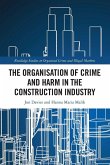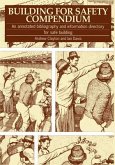Tchad Jatau, Fidelis Emuze, John Smallwood
Moving the Construction Safety Climate Forward in Developing Countries
Tchad Jatau, Fidelis Emuze, John Smallwood
Moving the Construction Safety Climate Forward in Developing Countries
- Broschiertes Buch
- Merkliste
- Auf die Merkliste
- Bewerten Bewerten
- Teilen
- Produkt teilen
- Produkterinnerung
- Produkterinnerung
This book intends to meet the needs of construction managers who, though technically informed, may struggle with managing frontline workers, especially regarding motivating positive safety outcomes.
Andere Kunden interessierten sich auch für
![The Organisation of Crime and Harm in the Construction Industry The Organisation of Crime and Harm in the Construction Industry]() Jon DaviesThe Organisation of Crime and Harm in the Construction Industry57,99 €
Jon DaviesThe Organisation of Crime and Harm in the Construction Industry57,99 €![Soft as Steel Soft as Steel]() Dennis DoranSoft as Steel18,99 €
Dennis DoranSoft as Steel18,99 €![Describing Construction Describing Construction]() Describing Construction74,99 €
Describing Construction74,99 €!['Rapid' Innovation: A Comparison of User and Manufactureer Innovations Through A Study of the Residential Construction Industry 'Rapid' Innovation: A Comparison of User and Manufactureer Innovations Through A Study of the Residential Construction Industry]() Sarah Slaughter'Rapid' Innovation: A Comparison of User and Manufactureer Innovations Through A Study of the Residential Construction Industry14,99 €
Sarah Slaughter'Rapid' Innovation: A Comparison of User and Manufactureer Innovations Through A Study of the Residential Construction Industry14,99 €![Building For Safety Compendium Building For Safety Compendium]() Andrew ClaytonBuilding For Safety Compendium32,99 €
Andrew ClaytonBuilding For Safety Compendium32,99 €![Rules, Requirements and Universal Safety Standards Rules, Requirements and Universal Safety Standards]() Carl M. HansenRules, Requirements and Universal Safety Standards17,99 €
Carl M. HansenRules, Requirements and Universal Safety Standards17,99 €![Hand Book Of Industrial Safety Standards Hand Book Of Industrial Safety Standards]() Hand Book Of Industrial Safety Standards17,99 €
Hand Book Of Industrial Safety Standards17,99 €-
-
-
This book intends to meet the needs of construction managers who, though technically informed, may struggle with managing frontline workers, especially regarding motivating positive safety outcomes.
Produktdetails
- Produktdetails
- Verlag: Routledge
- Seitenzahl: 126
- Erscheinungstermin: 29. September 2025
- Englisch
- Abmessung: 234mm x 156mm x 7mm
- Gewicht: 204g
- ISBN-13: 9781032421964
- ISBN-10: 1032421967
- Artikelnr.: 75242402
- Herstellerkennzeichnung
- Libri GmbH
- Europaallee 1
- 36244 Bad Hersfeld
- gpsr@libri.de
- Verlag: Routledge
- Seitenzahl: 126
- Erscheinungstermin: 29. September 2025
- Englisch
- Abmessung: 234mm x 156mm x 7mm
- Gewicht: 204g
- ISBN-13: 9781032421964
- ISBN-10: 1032421967
- Artikelnr.: 75242402
- Herstellerkennzeichnung
- Libri GmbH
- Europaallee 1
- 36244 Bad Hersfeld
- gpsr@libri.de
Tchad Sharon Jatau lectures in the Department of Quantity Surveying at Kaduna State University, Nigeria. Fidelis Emuze is Professor and Department Head in the Department of Built Environment at the Central University of Technology, Free State, South Africa. John Smallwood is Professor of Construction Management at Nelson Mandela University, South Africa.
Contents
List of Figures
List of Tables
Preface
Acknowledgements
CHAPTER 1 SAFETY CLIMATE IN CONSTRUCTION
1.1: Introduction
1.2: Construction safety in Sub-Saharan Africa
1.2.1: Noncompliance to Occupational Health and Safety (OHS) Regulations
1.3: Safety climate in construction operations
1.3.1: Construction safety performance
1.3.2: Management safety values
1.3.3: Safety performance indicators
1.3.4: Barriers to safety performance
1.4: Management safety practice
1.5: Construction workers' safety behaviour
1.6: H&S compliance issues in developing countries
1.7: Conclusions
References
CHAPTER 2 SAFETY PRIORITY
2.1: Introduction
2.2: Management safety commitment and practice
2.2.1: Managements' visible safety priority
2.3: Organisational safety policy
2.4: Workers' perceived safety priority and commitment
2.4.1: Compliance and commitment-based safety compliance among workers
2.4.2: Organisational citizenship behaviour
2.4.3: Counterproductive work behaviour
2.5: Management safety support
2.5.1: Safety-related behaviour
2.6: Safety priority issues in developing countries
2.7: Conclusions
References
CHAPTER 3 SAFETY EMPOWERMENT
3.1: Introduction
3.2: Worker empowerment
3.3: Safety empowerment in accident-prone workplaces
3.4: Safety education
3.5: Safety learning
3.6: Safety knowledge
3.7: Benefits of safety empowerment
3.8: Improved safety performance
3.9: Safety empowerment in developing countries
3.10: Conclusions
References
CHAPTER 4 SAFETY JUSTICE
4.1: Introduction
4.2: Organisational justice
4.3: Safety justice in the workplace
4.4: Incident reporting
4.5: Accountability in a just culture
4.6: Safety justice in developing countries
4.7: Conclusions
References
CHAPTER 5 SAFETY LEADERSHIP
5.1: Introduction
5.2: Safety leadership in construction
5.2.1: Big Five Personality Traits
5.3: Transactional safety leadership
5.4: Transformational safety leadership
5.5: Servant safety leadership
5.6: Workers' safety leadership behaviour
5.7: Conclusions
References
CHAPTER 6 SAFETY COMMITMENT
6.1: Introduction
6.2: Management safety commitment
6.3: Safety compliance and participation
6.4: Workers' safety commitment
6.5: Safety commitment in developing countries
6.6: Conclusions
References
CHAPTER 7 SAFETY COMMUNICATION
7.1: Introduction
7.2: Safety communication
7.2.1: Open safety communication
7.2.2: Perceived management openness
7.3: Safety training and education
7.3.1: Construction safety training methods
7.3.2: Safety Knowledge and communication
7.4: Safety communication in developing countries
7.5: Conclusions
References
CHAPTER 8 SAFETY TRUST
8.1: Introduction
8.2: Safety trust in construction
8.2.1: Antecedents of Safety Trust
8.2.2: Factors which influence workers' safety trust in management
8.3: Workers' trust in safety management systems
8.4: Safety distrust in construction
8.5: Benefits of safety trust
8.6: Safety trust in developing countries
8.7: Conclusions
References
List of Figures
List of Tables
Preface
Acknowledgements
CHAPTER 1 SAFETY CLIMATE IN CONSTRUCTION
1.1: Introduction
1.2: Construction safety in Sub-Saharan Africa
1.2.1: Noncompliance to Occupational Health and Safety (OHS) Regulations
1.3: Safety climate in construction operations
1.3.1: Construction safety performance
1.3.2: Management safety values
1.3.3: Safety performance indicators
1.3.4: Barriers to safety performance
1.4: Management safety practice
1.5: Construction workers' safety behaviour
1.6: H&S compliance issues in developing countries
1.7: Conclusions
References
CHAPTER 2 SAFETY PRIORITY
2.1: Introduction
2.2: Management safety commitment and practice
2.2.1: Managements' visible safety priority
2.3: Organisational safety policy
2.4: Workers' perceived safety priority and commitment
2.4.1: Compliance and commitment-based safety compliance among workers
2.4.2: Organisational citizenship behaviour
2.4.3: Counterproductive work behaviour
2.5: Management safety support
2.5.1: Safety-related behaviour
2.6: Safety priority issues in developing countries
2.7: Conclusions
References
CHAPTER 3 SAFETY EMPOWERMENT
3.1: Introduction
3.2: Worker empowerment
3.3: Safety empowerment in accident-prone workplaces
3.4: Safety education
3.5: Safety learning
3.6: Safety knowledge
3.7: Benefits of safety empowerment
3.8: Improved safety performance
3.9: Safety empowerment in developing countries
3.10: Conclusions
References
CHAPTER 4 SAFETY JUSTICE
4.1: Introduction
4.2: Organisational justice
4.3: Safety justice in the workplace
4.4: Incident reporting
4.5: Accountability in a just culture
4.6: Safety justice in developing countries
4.7: Conclusions
References
CHAPTER 5 SAFETY LEADERSHIP
5.1: Introduction
5.2: Safety leadership in construction
5.2.1: Big Five Personality Traits
5.3: Transactional safety leadership
5.4: Transformational safety leadership
5.5: Servant safety leadership
5.6: Workers' safety leadership behaviour
5.7: Conclusions
References
CHAPTER 6 SAFETY COMMITMENT
6.1: Introduction
6.2: Management safety commitment
6.3: Safety compliance and participation
6.4: Workers' safety commitment
6.5: Safety commitment in developing countries
6.6: Conclusions
References
CHAPTER 7 SAFETY COMMUNICATION
7.1: Introduction
7.2: Safety communication
7.2.1: Open safety communication
7.2.2: Perceived management openness
7.3: Safety training and education
7.3.1: Construction safety training methods
7.3.2: Safety Knowledge and communication
7.4: Safety communication in developing countries
7.5: Conclusions
References
CHAPTER 8 SAFETY TRUST
8.1: Introduction
8.2: Safety trust in construction
8.2.1: Antecedents of Safety Trust
8.2.2: Factors which influence workers' safety trust in management
8.3: Workers' trust in safety management systems
8.4: Safety distrust in construction
8.5: Benefits of safety trust
8.6: Safety trust in developing countries
8.7: Conclusions
References
Contents
List of Figures
List of Tables
Preface
Acknowledgements
CHAPTER 1 SAFETY CLIMATE IN CONSTRUCTION
1.1: Introduction
1.2: Construction safety in Sub-Saharan Africa
1.2.1: Noncompliance to Occupational Health and Safety (OHS) Regulations
1.3: Safety climate in construction operations
1.3.1: Construction safety performance
1.3.2: Management safety values
1.3.3: Safety performance indicators
1.3.4: Barriers to safety performance
1.4: Management safety practice
1.5: Construction workers' safety behaviour
1.6: H&S compliance issues in developing countries
1.7: Conclusions
References
CHAPTER 2 SAFETY PRIORITY
2.1: Introduction
2.2: Management safety commitment and practice
2.2.1: Managements' visible safety priority
2.3: Organisational safety policy
2.4: Workers' perceived safety priority and commitment
2.4.1: Compliance and commitment-based safety compliance among workers
2.4.2: Organisational citizenship behaviour
2.4.3: Counterproductive work behaviour
2.5: Management safety support
2.5.1: Safety-related behaviour
2.6: Safety priority issues in developing countries
2.7: Conclusions
References
CHAPTER 3 SAFETY EMPOWERMENT
3.1: Introduction
3.2: Worker empowerment
3.3: Safety empowerment in accident-prone workplaces
3.4: Safety education
3.5: Safety learning
3.6: Safety knowledge
3.7: Benefits of safety empowerment
3.8: Improved safety performance
3.9: Safety empowerment in developing countries
3.10: Conclusions
References
CHAPTER 4 SAFETY JUSTICE
4.1: Introduction
4.2: Organisational justice
4.3: Safety justice in the workplace
4.4: Incident reporting
4.5: Accountability in a just culture
4.6: Safety justice in developing countries
4.7: Conclusions
References
CHAPTER 5 SAFETY LEADERSHIP
5.1: Introduction
5.2: Safety leadership in construction
5.2.1: Big Five Personality Traits
5.3: Transactional safety leadership
5.4: Transformational safety leadership
5.5: Servant safety leadership
5.6: Workers' safety leadership behaviour
5.7: Conclusions
References
CHAPTER 6 SAFETY COMMITMENT
6.1: Introduction
6.2: Management safety commitment
6.3: Safety compliance and participation
6.4: Workers' safety commitment
6.5: Safety commitment in developing countries
6.6: Conclusions
References
CHAPTER 7 SAFETY COMMUNICATION
7.1: Introduction
7.2: Safety communication
7.2.1: Open safety communication
7.2.2: Perceived management openness
7.3: Safety training and education
7.3.1: Construction safety training methods
7.3.2: Safety Knowledge and communication
7.4: Safety communication in developing countries
7.5: Conclusions
References
CHAPTER 8 SAFETY TRUST
8.1: Introduction
8.2: Safety trust in construction
8.2.1: Antecedents of Safety Trust
8.2.2: Factors which influence workers' safety trust in management
8.3: Workers' trust in safety management systems
8.4: Safety distrust in construction
8.5: Benefits of safety trust
8.6: Safety trust in developing countries
8.7: Conclusions
References
List of Figures
List of Tables
Preface
Acknowledgements
CHAPTER 1 SAFETY CLIMATE IN CONSTRUCTION
1.1: Introduction
1.2: Construction safety in Sub-Saharan Africa
1.2.1: Noncompliance to Occupational Health and Safety (OHS) Regulations
1.3: Safety climate in construction operations
1.3.1: Construction safety performance
1.3.2: Management safety values
1.3.3: Safety performance indicators
1.3.4: Barriers to safety performance
1.4: Management safety practice
1.5: Construction workers' safety behaviour
1.6: H&S compliance issues in developing countries
1.7: Conclusions
References
CHAPTER 2 SAFETY PRIORITY
2.1: Introduction
2.2: Management safety commitment and practice
2.2.1: Managements' visible safety priority
2.3: Organisational safety policy
2.4: Workers' perceived safety priority and commitment
2.4.1: Compliance and commitment-based safety compliance among workers
2.4.2: Organisational citizenship behaviour
2.4.3: Counterproductive work behaviour
2.5: Management safety support
2.5.1: Safety-related behaviour
2.6: Safety priority issues in developing countries
2.7: Conclusions
References
CHAPTER 3 SAFETY EMPOWERMENT
3.1: Introduction
3.2: Worker empowerment
3.3: Safety empowerment in accident-prone workplaces
3.4: Safety education
3.5: Safety learning
3.6: Safety knowledge
3.7: Benefits of safety empowerment
3.8: Improved safety performance
3.9: Safety empowerment in developing countries
3.10: Conclusions
References
CHAPTER 4 SAFETY JUSTICE
4.1: Introduction
4.2: Organisational justice
4.3: Safety justice in the workplace
4.4: Incident reporting
4.5: Accountability in a just culture
4.6: Safety justice in developing countries
4.7: Conclusions
References
CHAPTER 5 SAFETY LEADERSHIP
5.1: Introduction
5.2: Safety leadership in construction
5.2.1: Big Five Personality Traits
5.3: Transactional safety leadership
5.4: Transformational safety leadership
5.5: Servant safety leadership
5.6: Workers' safety leadership behaviour
5.7: Conclusions
References
CHAPTER 6 SAFETY COMMITMENT
6.1: Introduction
6.2: Management safety commitment
6.3: Safety compliance and participation
6.4: Workers' safety commitment
6.5: Safety commitment in developing countries
6.6: Conclusions
References
CHAPTER 7 SAFETY COMMUNICATION
7.1: Introduction
7.2: Safety communication
7.2.1: Open safety communication
7.2.2: Perceived management openness
7.3: Safety training and education
7.3.1: Construction safety training methods
7.3.2: Safety Knowledge and communication
7.4: Safety communication in developing countries
7.5: Conclusions
References
CHAPTER 8 SAFETY TRUST
8.1: Introduction
8.2: Safety trust in construction
8.2.1: Antecedents of Safety Trust
8.2.2: Factors which influence workers' safety trust in management
8.3: Workers' trust in safety management systems
8.4: Safety distrust in construction
8.5: Benefits of safety trust
8.6: Safety trust in developing countries
8.7: Conclusions
References








